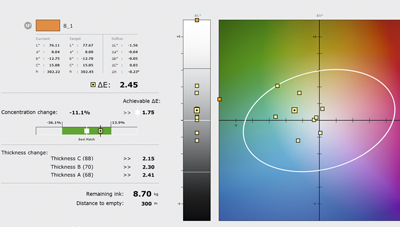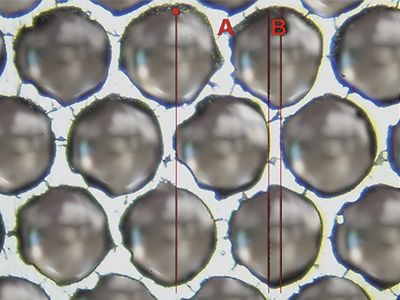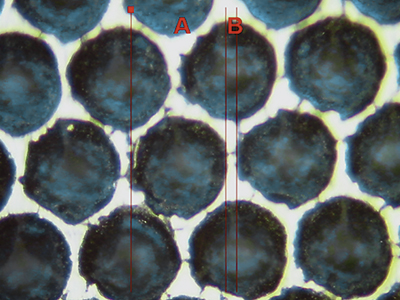Cells before cleaning
Colour management is one of the most crucial parts of the flexo printing process. In order to implement comprehensive colour management, printers must ensure that the measurement, control and necessary adjustments are applied to every part of the process. Michal Lodej reports.
When considering colour management in any print related workflow, it is important to recognise the ultimate aim; that is to achieve comparable results between any customer approved proof and the final print produced on press. The flexographic workflow, from design through to press is one of the most challenging of print processes. Nevertheless, correctly managing colour through each stage of the process can deliver cost, material and time savings.
In the first instance, a specific reference printing condition or reference should be specified and agreed upon by the provider and the receiver. This will enable all parties from designer through to pre-press and press operator to understand the customer expectation.
Steve Donegan, from Graphic Republik, said, ‘The reference may relate to a pre-determined printing standard or may require a set of new characterisation data to be printed and the data recorded. Irrespective, the goal is to identify reference data that describes how a particular printing system will reproduce a particular design.’
With the reference agreed, the data is used in pre-press to generate profiles for the purpose of colour management. These profiles will be used to convert images into the correct colour space, such as RGB to CMYK. If a particular design is being used for multiple print processes such as litho or gravure, the profiles can be used to manage the colour conversion to a flexo environment.
The profiles will also be used as a target reference for any colour inkjet proofs generated. These proofs allow the pre-press department to supply all stakeholders (customer, designer, press operator) with a true representation of the final printed design.
Further down the line
Whilst the platemaking department may not be directly involved in the colour management workflow, the RIP used to process the design files will use the characterisation data to ensure the correct dot gain curves are applied to the raster data. Aside from the design, these raster files used to make plates will also include process control elements which will allow the press operator to measure and if necessary, adjust colour on press.

Colour managing software can be crucial to reaching colour targets but the whole workflow needs to finely tuned to be accurate
So the press operator is responsible for ensuring the print matches any supplied proof samples. In the instance that the reference data was generated as part of a characterisation process, the press operator must ensure that the same components used then are used now.
These components which include anilox, mounting tape and ink can all have an impact on the colour produced on press. Just as in the pre-press department, to ensure accuracy and consistency, a colour measurement device which will allow the operator to record data, adjust colour and achieve the desired result is essential.
All the variables
By following a set process and measuring then controlling variables, consistent results can be achieved. But to say there are many variables to consider would be an understatement. Printing machinery needs to be mechanically sound; inks need to be formulated consistently for repeat jobs; anilox cell volumes must be monitored and screen specifications considered. Other variables such as doctoring methods, ink pumps, plate material and the density of plate mounting foam all play an important part in achieving consistent print quality.
Steve Turner, managing director at Print-Tech Solution, said, ‘Fast setup times and consistent results have become a priority for our customers. Unless you are extremely lucky, failure to master this process can lead to serious amounts of lost time and money. Leaving the fine detail until the job is about to be run can be a costly mistake. At this stage costs have already been incurred, ‘make-ready’ time accounting for a large part of the overall manufacturing cost. Now is not the time to realise that the anilox roller is worn, damaged or dirty!’

Cells after cleaning with Print-Tech Solution’s ThermoPod anilox cleaning solution
‘Instinctively when a colour management issue arises the usual suspect tends to be the ink formulation. However in our experience, the real culprit affecting colour management is often the anilox cell volume. The one thing which connects the ink and the printing plate – the anilox roller – often gets neglected. Our training encourages customers to think of the printing process as a chain, where each link is reliant on the previous one to give the chain its strength… a break in the chain can have disastrous results, costing businesses time and money.’
Through continued support and training, the company is introducing and encouraging the technical awareness of its customers to a level that will help towards continued in-house colour management.
Mr Turner concluded, ‘The success of our business has been based on developing partnerships with our customers. We encourage them to fully understand our products, which in turn promotes awareness and ownership, helping them to use these products effectively. Our involvement actually starts well in advance of the printing process, by supplying specialised cleaning products and machinery which maintain the condition of some of the pivotal components of the printing process, in particular anilox rollers and printing plates. For example, before the print process even begins, anilox rollers need to be at the correct specification and condition for the job, otherwise all efforts taken to control other parts of the process such as inks, plates etc will be in vain.’
As one
Isaam Lutfiyya, strategic planning & global business development at QuadTech, said, ‘Our aim is to simplify colour management, to move away from a silo approach to colour management. Typically today the pre-press specification is in one place, the ink in another and the print yet another. We’ve attempted to get away from that approach with a tool that follows the workflow. It is more intuitive. ColorTrack and DeltaCam enable a print shop to manage colour from the moment it comes in from the specifier. It is a end to end solution.’
Mr Lutfiyya explained, ‘After importing the specs in the quality department they then go to the ink kitchen as an ink specification that can be used by the ink recipe software. An ink recipe will get you to the right neighbourhood but not necessarily the right house. So a correction is necessary. With ColorTrack that takes one or two attempts rather than the six or seven common today – so immediately the benefit is at least a 50% reduction in ink matching.
‘The software runs a diagnostic and can define the delta E possible through each change. This can change the way printers operate their workflow. For example if it is a delta E of one change required, that might be possible just by changing the anilox with no need for reformulation. The software is a colour expert in a box.
Customer Management
Most printers take an offline measurement at the beginning of the roll, in the middle and at the end. Color Track produces thousands of measurements along the whole roll. With the aim of correcting errors before they get out of tolerance and become waste.
Mr Lutfiyya, continued, ‘It is hard to calculate the savings as there is no benchmark. The level of data is not there today, and no one wants to run the system without using the correction once they have it. Packaging printers are very tight lipped. They don’t generally discuss how many returned rolls per year and how much it costs. Generally though it is a six figure sum, even of it’s just a couple of rolls. When considering the ROI the DeltaCam Hardware, basic including install and training can total $44,000. But if it eliminates one or two returned rolls in the first year the system has paid for itself.’
Good colour management also allows you to re-use the same inks for different jobs – either by slight reformulating or other process changes. For instance if a printer has a McDonalds job come in and they have a lot of Ferrari red ink in the inventory inventory, by changing the anilox that ink can hit the target for the new job.
Mr Lutfiyya concluded, ‘One of our early customers has reduced the space of its ink inventory from 1,200 msq to 200 msq by working this way. A space that had barrels stacked from floor to ceiling has been emptied out and is now used to house a new press.’
Read the full July/August issue of FlexoTech here. Subscribe to the magazine for free – register your details here.






